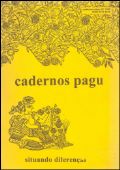Resumo
Resumo:
O artigo visa publicar e comentar algumas das raras evidências femininas produzidas pelas próprias mulheres romanas. Pontos de vista falocêntricos e a partir do senso comum são criticados e o autor termina conclamando a realização de um programa de coleta e estudo das evidências referentes às mulheres romanas.
Referências
ADAMS, John: The Latin Sexual Vocabulary. Londres, Duckworth, 1987, p. 122.
BING, Peter e COHEN, Robert: Games of Venus. An Anthology of Greek and Roman Erotic Verse from Sppho to Ovid. Londres, Routledge, 1991, p.1.
BIRLEY, Robin: The Roman documents from Vindolanda. Newcastle-upon-Tyne, Roman Army Museum publications, 1990, pp. 14-16.
BOARDMAN, John: "The Phallos-Bird in Archaic and Classical Greek Art", IN Révue Archéologique,2, 1992, pp. 239-240 et passim.
BRADLEY, Keith: Slavery and Society at Rome. Cambridge, Cambridge University Press, 1994, p.49
BROWN, Susan: "Feminist Theory in Archaeology: What does it Mean?", IN RABINOWITZ, N.S. e RICHLIN, A. (eds.): Feminist Theory and the Classics. Londres, Routledge, 1993, p. 261.
CANTARELLA, Eva: Secondo Natura. La bisessualità nel mondo antico. Roma, Riuniti, 1988, p. 189.
CLARCKE, John: "The Warren Cup and the Contexts for Representations of Male-to-Male Love Making in Augustan and Early Julio-Claudian Art", IN The Art Bulletin, 75,2, 1993, p.284.
COPLEY, Frank Olin: "A Paracalausthyron from Pompeii: a study of CIL IV, 5296", IN American Journal of Philology, 60, 1939, pp.337,349.
DELLA VALLE, Giorgio: "L'amore in Pompei e nel poema di Lucrezio", IN Atene e Roma,2,5, 1937, p.151.
FAIRCLOUGH, Norman: Language and Power. Londres, Longman, 1990 et passim.
FUNARI, Pedro Paulo Abreu: La cultura popular en la Antiguedad Clásica. Écija, Editorial Sol, 1991, p.70.
GILMORE, David: "Men and Women in Southern Spain: "domestic power" revisited", IN American Anthropologist, 92,4, 1990, pp.953, 965 et passim.
GOLD, Barbara: "'But Aridne was never there in the first place': finding female in Roman Poetry", IN RABINOWITZ, N.S. e RICHLIN, A. (eds), Feminist Theory and the Classics. Londres, Routledge, 1993, pp. 75-101.
HALLETT, Judith: "Feminist Theory, Historical Periods, Literary Canons, and the Study of Greco-Roman Antiquity", IN RABINOWITZ, N.S. e RICHLIN, A. (eds.): Feminist Theory and the Classics. Londres, Routledge, p.53.
HIDALGO, Maria José: "Mujeres, carisma y castidad en el cristianismo primitivo", IN Gerión, 11, 1993, pp.229-244.
IMBERT, Claude: "Stoic Logic and Alexandrian Poetics", IN SCHOFIELD, M. (ed), Doubt and Dogmatism, Studies in Hellenistic Epistemologies. Oxford, Claredon Press, 1980, p.208.
JENSON, Joan: "Representation of Difference: the Varieties of French Feminism", IN New Left Review, 180, 1990, p. 130.
LING, Roger: Roman Painting. Cambridge, Cambridge University Press, 1991.
MORGAN, David: Discovering Men. Londres, Routledge, 1993, p. 194.
PANAYOTAKIS, Costas: "A Sacred Ceremony in Honour of the Buttocks: Petronius, Satyrica 140.1-11", IN Classical Quarterly, 44,2, 1994, pp. 458-467.
PANAYOTAKIS, Costas: "Quartilla's Histrionics in Petronius, Satyrica 16.1-26.6", IN Mnemosyne, 47,3, 1994, pp. 319-336
PANAYOTAKIS, Costas: "Theatrical elements in the Episode on Board Lichas' ship (Petronius, Satyrica 99.5-115)", IN Mnemosyne, 47,5, 1994, pp. 596-624.
PASSMAN, Tina: "Out of the Closet and into the Field: matriculture, the Lesbian Perspective, and Feminist Classics", IN RABINOWITZ, N.S. e RICHLIN, A. (eds.): Feminist Theory and the Classics. Londres, Routlege, 1993.
PINA-CABRAL, João: "Tamed Violence: Genital Symbolism in Portuguese Popular Culture", IN Man (NS), 28,1,1993, p.118
RABINOWITZ, Nancy Sorkin: "Introduction", IN RABINOWITZ, N.S e RICHLIN, A. (eds.): Feminist Theory and the Classics. Londres, Routledge, 1993, p.1
RICHLIN, Amy: "Hijacking the Palladion: Feminists in Classics", IN Gender and History, 4,1, pp.70-83.
RICHLIN, Amy: The Garden of Priapus. Sexuality and aggression in Roman Humor. New Haven, Yale University Press, 1983, p.81
ROSE, Peter: "The Case for not Ignoring Marx in the Study of Women in Antiquity", IN RABINOWITZ, N.S. e RICHLIN, A. (eds): Feminist Theory and the Classics. Londres, Routledge, p.215.
SHELTON, John: "Pliny the Younger, and the Ideal Wife", Classica et Medievalia, 41, 1990, pp.163-186.
SKINNER, Marilyn: "Woman and Language, in Archaic Greece, or Why is Sappho a Woman?", IN RABINOWITZ, N.S. e RICHLIN, A. (eds.): Feminist Theory and the Classics. Londres, Routledge, 1993.
SYMONDS, Robin: Rheinish Wares. Fine Dark Coloured Pottery from Gaul and Germany. Oxford, Oxford Committee for Archaeology, 1992, fig.22, número 444.
TOMLIN, Roger: "The Curse Tablets", IN CUNLIFFE, Barry (ed), The Temple of Sulis Minerva at Bath, volume 2, The Finds from the Sacred Spring. Oxford, Oxford Committe for Archaeology, 1988, p. 192.
VARONE, Antonio: Erotica Pompeiana. Roma, L'Erma di Bretschneder, 1994, pp. 99-101.
ZANKER, Paul: The Power of Images in the Age of Augustus. Ann Arbor, University of Michigan Press, 1990, p.176 et passim

